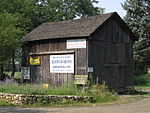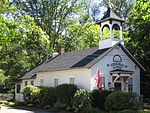Devil's Den Preserve
The Lucius Pond Ordway Devil's Den Preserve in Weston and Redding, Connecticut, encompassing 1,746 acres (7.07 km2), is the largest preserve in Fairfield County, Connecticut and one of the larger preserves in the metropolitan New York area. The preserve's name derives from local lore: charcoal makers in the hilly, rocky area would say that a hoof-like mark made in a boulder was the footprint of the Devil.Devil's Den is the most frequently visited preserve (and largest contiguous preserve) run by the Connecticut chapter of the Nature Conservancy, with 40,000 visits per year. The main entrance is at the end of Pent Road in Weston. The park is open from dawn till dusk. The New Canaan Nature Center runs programs and hikes in the woody park. The preserve has 20 miles (32 km) of trails, and maps are available at the Pent Road parking area. The preserve is part of the watershed of the West Branch of the Saugatuck River and part of the extended 70-mile (110 km) "Saugatuck Valley Trails System".Flora and fauna in the preserve include more than 500 types of trees and wildflowers, the pink lady's slipper, cardinal flower, and Indian pipe, such animals as red fox, bobcat, coyote, and eastern copperhead snake, and more than 140 bird species, including wood duck, ruffed grouse, and pileated woodpecker.
Excerpt from the Wikipedia article Devil's Den Preserve (License: CC BY-SA 3.0, Authors).Devil's Den Preserve
Pent Road,
Geographical coordinates (GPS) Address Nearby Places Show on map
Geographical coordinates (GPS)
| Latitude | Longitude |
|---|---|
| N 41.2365 ° | E -73.396 ° |
Address
Pent Road 26
06883
Connecticut, United States
Open on Google Maps








